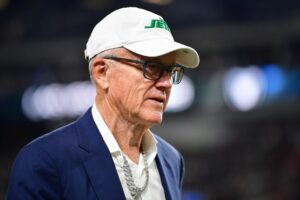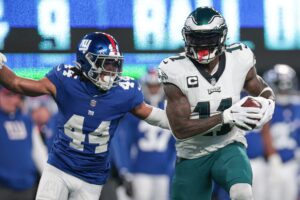The Baltimore Ravens are a team that, historically, has always done its most important work through the draft. Collecting picks as opposed to paying for highly touted free agents has always been the motto for general manager Eric DeCosta‘s team — as well as under his predecessor Ozzie Newsome. In their 25 years as a franchise, the Ravens have already drafted three Hall-of-Famers and likely have another three set to enter when they’re eligible. Could they add even more in this Ravens mock draft?
Coming off of their best regular season in franchise history, Baltimore will be looking to finalize a roster that is already one of the deepest in the NFL. The Ravens have already added perennial All-Pro Calais Campbell via trade, interior pass rush specialist Derek Wolfe via free agency and retained consistent contributors Matt Judon and Jimmy Smith this off-season. However, there are still a number of needs on the defense. Improving the entire front-seven was the number-one priority this off-season and the Ravens are still thin at a number of positions. There is also the matter of giving reigning NFL MVP Lamar Jackson more weaponry to work with. The Ravens had the best yardage offense in the entire NFL in 2019 but still remain thin at receiver and lost one of the tight ends – Hayden Hurst – of their three-headed monster over the middle.
In 2020, the Ravens have nine picks in the draft — including seven in the first four rounds. These are nine potential selections DeCosta and the Ravens could make with their draft picks in the upcoming NFL Draft.
Baltimore Ravens Seven Round Mock Draft 2020
Note: This mock draft was determined with the Draft Network’s ‘Mock Draft Machine‘ using the TDN predictive board for the other 31 team’s picks
First Ravens Mock Draft Pick: 1st Round (28th overall): Kenneth Murray (Oklahoma) – Linebacker
Since the conclusions of the college football and NFL regular season, there has been no player less mocked to the Ravens than Murray. C.J. Mosley left the Ravens for the New York Jets during 2019 free agency and his All-Pro sized roster hole was never filled throughout the season. The Ravens were noticeably missing a presence in the middle of their defense to start the 2019 season so much so that they completely revamped the unit just a month into the season.
Murray is maybe the fastest linebacker in the entire draft and could come into Baltimore and be a day-one starter at weakside linebacker. The Ravens would ideally like him to translate to a true Mike linebacker as he has ideal size to play the position. His ability to get sideline-to-sideline is some of the best of any player in the draft and he should be great at stopping the run from the outside. Inside linebacker is the weakest position group on the Ravens roster and getting a good value that fills a need, like Murray, is ideal in a first-round pick.
2nd Round (55th overall): Brandon Aiyuk (Arizona State) – Wide Receiver
Considering the output that the Ravens offense had in 2019, it’s hard to imagine they have a glaring need anywhere on their team. However, receiver is still a big need. Jackson did wonders with the receiving crops he was given but outside of Marquise Brown, Baltimore’s wide receivers were far from reliable. Jackson threw the majority of his passes to tight ends and one of the three on the roster – Hayden Hurst – was recently traded to the Atlanta Falcons.
Aiyuk may not contain the blazing speed (he logged a 4.5 Forty time at the NFL combine) but he is more than fast enough to succeed in the NFL as a good downfield and intermediate option. He’s a menace in the open field and could be very valuable on screens as well as help the Ravens fill the returner role they’ve been lacking over the past few seasons. Aiyuk averaged 10.9 yards after the catch during the 2019 college football season. Combining his athleticism with the already lightning-fast Brown could give the Ravens offense a big-play ability that is only parallelled by the Kansas City Chiefs.
2nd Round (60th overall): Julian Okwara (Notre Dame) – EDGE
The Ravens came out of 2019 with their pass rush being a glaring weakness on defense. They were unable to replace the production of Za’Darius Smith and Terrell Suggs, even though Judon had a career-season. It also came as a surprise that DeCosta did not add a pass rusher on the outside in free agency. The addition of Campbell will give Baltimore a good presence up the middle but with so much uncertainty on the outside, the Ravens need to add another pass rusher on the outside.
On tape, Okwara looks like one of the most explosive pass rushers in the draft. When he gets a ball-carrier clear in his sights, he’s going to get to him. Okwara didn’t produce the way he would’ve liked to in his senior season, missing games due to injury and posting subdued numbers because of it. He’s not much of a presence in the run game either. However, he fits the Ravens as a pass rush specialist early and could develop into an every-down EDGE defender. He played as both a stand-up and hand-down defensive end at Notre Dame has shown a little ability to drop into coverage. Don Martindale likes to use a rotation of pass rushers and Okwara could be a big boost to a shallow unit.
3rd Round (92nd overall): Zack Moss (Utah) – Running Back
Pounding the ball was the Raven’s specialty in 2019. They set a new NFL record for total rushing yards in a season behind Jackson and a committee of running backs. Of that committee, the only running back that is under contract in Baltimore past 2020 is Justice Hill. Mark Ingram was the strongest contributor in the backfield in 2019 but will be 31 years old by the end of the 2020 season. The shelf life of running backs after the age of 30 is uncertain.
While Moss may not be the tallest back at 5’10”, he’s plenty big enough to run through you at 222 lbs. Similar to Ingram, with the ball in his hands, Moss does not like going down. His mix of motor and size makes him a broken tackle machine and could translate into a three-down back if he is able to hit his ceiling. At Utah, he showed an ability to both catch the ball and plow thr0ugh defenders. Moss finished his senior year with 1,416 rushing yards and 388 receiving yards. Succeeding Ingram would be really hard but having a backfield already containing Hill and Moss in 2021 isn’t a bad place to start.
3rd Round (106th overall): Thaddeus Moss (LSU) – Tight End
The tight end class in 2020 is likely the weakest of any position group in the entire draft and there are very few players who even look to contain NFL starting capability. The Ravens’ tight ends caught a total of 125 balls between the three of them last season — 43% of the team’s total receptions. Mark Andrews led the entire team in receptions with 60. Losing Hurst to the Falcons leaves the Ravens with only two tight ends on the roster and the Ravens are bound to add another tight end before the start of next season.
While Moss may not jump off the screen as a dynamic playmaker from his position, he does a decent job at both blocking and catching the football. Getting a player that the Ravens can play on any down would be very valuable to Greg Roman. Andrews and Nick Boyle are specialists at receiving and blocking, respectively, and finding a player that can do a bit of both is ideal for third-stringer. Hurst filled this role just a season ago. Moss fits the do-it-all mold of what the Ravens should be looking to add.
4th Round (129th overall): Shane Lemieux (Oregon) – Interior Offensive Line
With Marshal Yanda retiring early in the off-season, the future Hall of Famer leaves a humungous hole on the Ravens offensive line. The interior of the offensive line was already a concern going into 2019 and losing a key piece like Yanda creates even more questions. Each Matt Skura, Bradley Bozeman, and Patrick Mekari had solid seasons but are all natural centers. 2019 fourth-round pick Ben Powers has a chance to crack the starting lineup next season but Baltimore only has seven offensive linemen with NFL experience on their roster.
Lemieux was a four-year starter at Oregon and started each of his 52 straight games played at left guard on one of the best offensive lines in college football. He’s an incredibly physical and strong guard who could excel in the Ravens run-heavy scheme. His best trait is his ability stun blockers going forward off of the snap but is not an elite athlete at the second level. Lemieux could be one of the best mid-round fits for Baltimore on the offensive line.
4th Round (134th overall): Collin Johnson (Texas) – Wide Receiver
The Ravens receiving corps was overhauled at the beginning of last season and the operation will likely continue into this year’s draft. Baltimore drafted two receivers in 2019, Marquise Brown and Miles Boykin, and both figure to be major parts of the offense in 2020. Behind them, the Ravens have very few proven options. Even if DeCosta is to draft a receiver in the first two rounds, taking a couple of shots at the position could heavily benefit the Ravens.
Johnson would bring a different dimension to the Ravens offense. At 6’6″ 222 lbs, he has the prototypical build of a possession receiver. His production fell off during his senior year but his season was heavily hampered by injuries that limited him to just seven games played in 2019. Prior to last season, Johnson was steadily improving his production every year. Every year I have one mid-round player that I think just makes too much sense for the Ravens to add. In 2018 it was Mark Andrews, in 2019 it was Justice Hill and in 2020 it’s Johnson.
5th Round (157th overall): Josiah Scott (Michigan State) – Cornerback
DeCosta has done a lot of very smart things as the Ravens’ general manager over the past two off-seasons but perhaps his smartest move has been collecting good corners. Baltimore has one of the best secondaries in all of football and Scott could provide necessary depth going forward. He’s not a big corner at 5’9″ 185 lbs but he attacks the ball from his drop. Scott picked off three balls and added six pass defenses during his junior year with the Spartans. Tavon Young has two years left on his contract and Scott could be necessary depth as a nickel/slot corner if he develops well down the road.
Final Ravens Mock Draft Pick: 7th Round (226th overall): Kamal Martin (Minnesota) – Linebacker
Even if the Ravens are to pick a linebacker within the first two rounds of the draft, DeCosta could easily target another later. L.J. Fort is the only consistent contributor in the linebacking corps returning from the 2019 team and bringing in competition at the position is vital. Martin is a downhill thumper with the ability to play a potential role in the run game at the NFL level. He’s limited in the passing game but has ideal size for an inside linebacker. The 2020 linebacking class is very top-heavy and if the Ravens were to target a linebacker, it would likely be later in the draft rather than in the middle.
Missed Ravens Mock Draft Needs: Interior Defensive Line
The Ravens did a good job of filling their defensive line in the offseason. Adding Campbell from the Jacksonville Jaguars and Wolfe from the Denver Broncos gives the Ravens two very good interior pass rushers. However, there could still be a need to add more given Baltimore’s depth situation. Defensive tackle isn’t a particularly deep position group in this year’s draft either. If the Ravens are to take a defensive tackle, it won’t be by reaching. Their defensive line is maybe the best they’ve had since Haloti Ngata anchored the unit in 2012 but they could always use reinforcements. Mid-season signee Justin Ellis, fullback Patrick Ricard and 2019 sixth-round pick Daylon Mack are the current second-string options on the Ravens depth chart.
Main photo:
Embed from Getty Images






